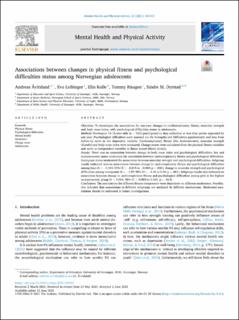| dc.contributor.author | Åvitsland, Andreas | |
| dc.contributor.author | Leibinger, Eva | |
| dc.contributor.author | Kolle, Elin | |
| dc.contributor.author | Haugen, Tommy | |
| dc.contributor.author | Dyrstad, Sindre Mikal | |
| dc.date.accessioned | 2021-12-08T12:35:03Z | |
| dc.date.available | 2021-12-08T12:35:03Z | |
| dc.date.created | 2021-06-21T10:24:44Z | |
| dc.date.issued | 2021 | |
| dc.identifier.citation | Mental Health and Physical Activity. 2021, 21(Oktober 2021), Artikkel 100411. | en_US |
| dc.identifier.issn | 1755-2966 | |
| dc.identifier.uri | https://hdl.handle.net/11250/2833352 | |
| dc.description | This is an open access article under the CC BY license (http://creativecommons.org/licenses/by/4.0/). | en_US |
| dc.description.abstract | Objectives
To investigate the associations for one-year changes in cardiorespiratory fitness, muscular strength and body mass index, with psychological difficulties status in adolescents.
Methods
Norwegian 14-15-year-olds (n = 925) participated in data collection at two time points separated by one year. Psychological difficulties were assessed via the Strengths and Difficulties questionnaire and data from follow-up serve as the dependent variable. Cardiorespiratory fitness (the Andersen-test), muscular strength (Eurofit) and body mass index were measured. Change scores were calculated from the physical fitness variables and serve as independent variables in linear mixed effects models.
Results
There was no association between change in body mass index and psychological difficulties. Sex and socioeconomic status moderated the association between cardiorespiratory fitness and psychological difficulties. Immigrant status moderated the association between muscular strength and psychological difficulties. Subgroup results indicated inverse associations between change in cardiorespiratory fitness and psychological difficulties among boys (b = −0.009; 95% CI = −0.015 to −0.003; p = .006); change in muscular strength and psychological difficulties among immigrants (b = −1.97; 95% CI = −4.03 to 0.09; p = .061). Subgroup results also indicated an association between change in cardiorespiratory fitness and psychological difficulties among girls in the highest socioeconomic group (b = 0.014; 95% CI = 0.003 to 0.025; p = .014).
Conclusions
The associations for different fitness components were dependent on different moderators. Possibly, this indicates that associations in different subgroups are mediated by different mechanisms. Moderated associations should be addressed in future investigations.
Highlights
• This study used change scores for three separate physical fitness components.
• Moderators were examined.
• Increased cardiorespiratory fitness indicated less psychological difficulties among boys.
• Increased muscular strength indicated less psychological difficulties among immigrants.
• Increased cardiorespiratory fitness indicated more psychological difficulties among girls with high socioeconomic status. | en_US |
| dc.language.iso | eng | en_US |
| dc.subject | adolescents | en_US |
| dc.subject | change score | en_US |
| dc.subject | mental health | en_US |
| dc.subject | moderator | en_US |
| dc.subject | physical fitness | en_US |
| dc.subject | psychological difficulties | en_US |
| dc.title | Associations between changes in physical fitness and psychological difficulties status among Norwegian adolescents | en_US |
| dc.type | Peer reviewed | en_US |
| dc.type | Journal article | en_US |
| dc.description.version | publishedVersion | en_US |
| dc.rights.holder | © 2021 The Authors | en_US |
| dc.source.pagenumber | 9 | en_US |
| dc.source.volume | 21 | en_US |
| dc.source.journal | Mental Health and Physical Activity | en_US |
| dc.identifier.doi | 10.1016/j.mhpa.2021.100411 | |
| dc.identifier.cristin | 1917167 | |
| dc.description.localcode | Institutt for idrettsmedisinske fag / Department of Sports Medicine | en_US |
| dc.source.articlenumber | 100411 | en_US |
| cristin.ispublished | true | |
| cristin.fulltext | original | |
| cristin.qualitycode | 1 | |
